I've got a "canvas" that the user can draw pixels, etc. onto. It works well, but my zoom functionality currently uses the same origin regardless of the position of the mouse. I'd like to implement functionality like that of Google Maps' zoom behaviour:
That is, the zoom's origin should always be the position of the mouse cursor.
What I currently have is not exactly right...
My attempts have mostly been stabs in the dark, but I've also tried using the code from this answer without success.
main.cpp:
#include <QGuiApplication>
#include <QtQuick>
class Canvas : public QQuickPaintedItem
{
Q_OBJECT
public:
Canvas() :
mTileWidth(25),
mTileHeight(25),
mTilesAcross(10),
mTilesDown(10),
mOffset(QPoint(400, 400)),
mZoomLevel(1)
{
}
void paint(QPainter *painter) override {
painter->translate(mOffset);
const int zoomedTileWidth = mTilesAcross * mZoomLevel;
const int zoomedTileHeight = mTilesDown * mZoomLevel;
const int zoomedMapWidth = qMin(mTilesAcross * zoomedTileWidth, qFloor(width()));
const int zoomedMapHeight = qMin(mTilesDown * zoomedTileHeight, qFloor(height()));
painter->fillRect(0, 0, zoomedMapWidth, zoomedMapHeight, QColor(Qt::gray));
for (int y = 0; y < mTilesDown; ++y) {
for (int x = 0; x < mTilesAcross; ++x) {
const QRect rect(x * zoomedTileWidth, y * zoomedTileHeight, zoomedTileWidth, zoomedTileHeight);
painter->drawText(rect, QString::fromLatin1("%1, %2").arg(x).arg(y));
}
}
}
protected:
void wheelEvent(QWheelEvent *event) override {
const int oldZoomLevel = mZoomLevel;
mZoomLevel = qMax(1, qMin(mZoomLevel + (event->angleDelta().y() > 0 ? 1 : -1), 30));
const QPoint cursorPosRelativeToOffset = event->pos() - mOffset;
if (mZoomLevel != oldZoomLevel) {
mOffset.rx() -= cursorPosRelativeToOffset.x();
mOffset.ry() -= cursorPosRelativeToOffset.y();
// Attempts based on https://stackoverflow.com/a/14085161/904422
// mOffset.setX((event->pos().x() * (mZoomLevel - oldZoomLevel)) + (mZoomLevel * -mOffset.x()));
// mOffset.setY((event->pos().y() * (mZoomLevel - oldZoomLevel)) + (mZoomLevel * -mOffset.y()));
// mOffset.setX((cursorPosRelativeToOffset.x() * (mZoomLevel - oldZoomLevel)) + (mZoomLevel * -mOffset.x()));
// mOffset.setY((cursorPosRelativeToOffset.y() * (mZoomLevel - oldZoomLevel)) + (mZoomLevel * -mOffset.y()));
update();
}
}
void keyReleaseEvent(QKeyEvent *event) override {
static const int panDistance = 50;
switch (event->key()) {
case Qt::Key_Left:
mOffset.rx() -= panDistance;
update();
break;
case Qt::Key_Right:
mOffset.rx() += panDistance;
update();
break;
case Qt::Key_Up:
mOffset.ry() -= panDistance;
update();
break;
case Qt::Key_Down:
mOffset.ry() += panDistance;
update();
break;
}
}
private:
const int mTileWidth;
const int mTileHeight;
const int mTilesAcross;
const int mTilesDown;
QPoint mOffset;
int mZoomLevel;
};
int main(int argc, char *argv[])
{
QGuiApplication app(argc, argv);
qmlRegisterType<Canvas>("App", 1, 0, "Canvas");
QQmlApplicationEngine engine;
engine.load(QUrl(QStringLiteral("qrc:/main.qml")));
return app.exec();
}
#include "main.moc"
main.qml:
import QtQuick 2.5
import QtQuick.Window 2.2
import App 1.0 as App
Window {
visible: true
width: 1200
height: 900
title: qsTr("Hello World")
Shortcut {
sequence: "Ctrl+Q"
onActivated: Qt.quit()
}
App.Canvas {
focus: true
anchors.fill: parent
}
}
What am I doing wrong in the wheelEvent() function?


 ,
,


